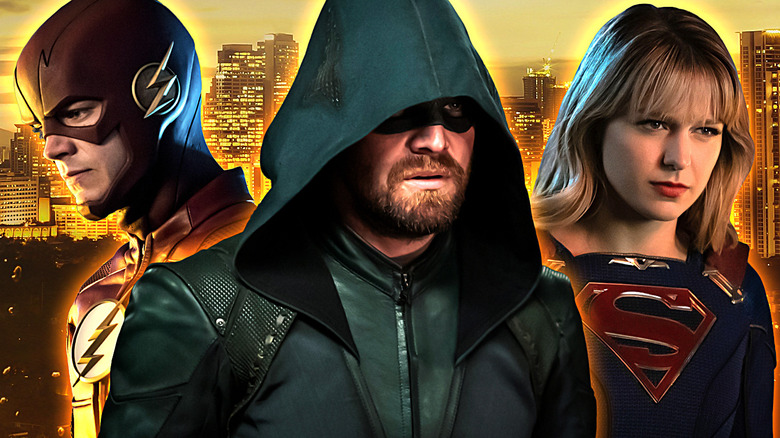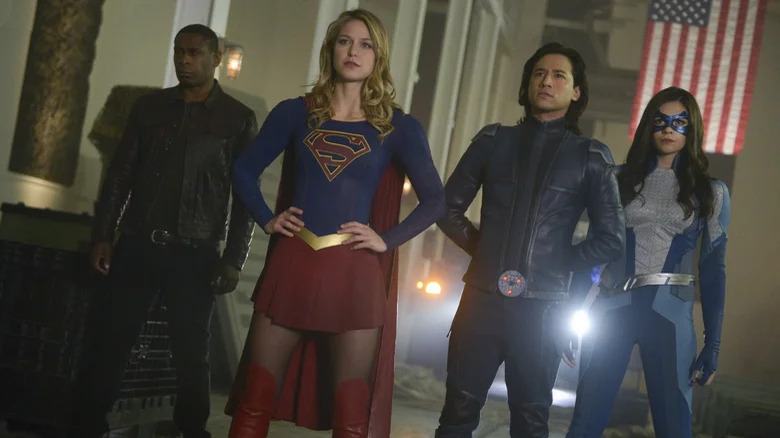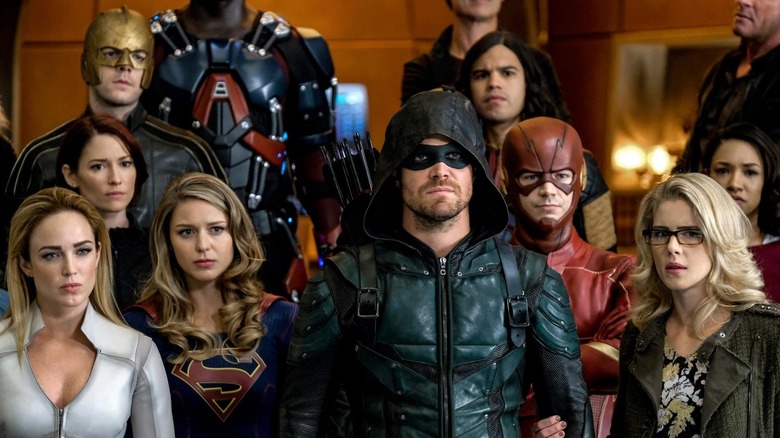The Correct Order To Watch The Arrowverse Shows (Including The Crossover Events)
The Arrowverse was truly an astounding piece of television storytelling, a daring experiment that set the standard for how to do interconnected universes on TV, and for how to bring DC heroes to the small screen in live-action. This vital part of TV history came about as superheroes were dominating the big screen and departed just as superhero media ceased to be a surefire bet.
Even today, the Arrowverse remains something special, a universe filled with shows of different tones and approaches. Before the Netflix Marvel series tried to distinguish one another with different color filters, the Arrowverse got started with the "Batman Begins"-esque "Arrow" — a show with many ups and downs, but an unquestionable legacy. After that came the silly and soapy superhero saga that is "The Flash" (which explored the multiverse years before the concept came to dominate the superhero genre), the progressive and idealistic "Supergirl," the noir-inspired "Batwoman," the zany and weird yet thoughtful and heartwarming "Legends of Tomorrow," and many other shows.
Before the DC Universe combines live-action and animation in the same continuity (which even Marvel hasn't fully attempted yet), the Arrowverse gave us characters that jumped from live-action to animation and back again. It also brought over characters from entirely different networks and made them staples of its own multiverse, like Matt Ryan's John Constantine. Then there were the crossover events, which gave audiences some truly spectacular moments — particularly "Crisis on Infinite Earths," which brought together several eras of superhero stories and dozens of well-considered cameos much more effectively than either the live-action 2023 "Flash" movie or DC Animation's three-part "Justice League: Crisis on Infinite Earths" adaptation.
That's a whole lot of media for newcomers to navigate ... which is where we come in.
The correct order to watch the Arrowverse shows
With nearly 700 episodes across 37 different seasons of TV, the Arrowverse may not be near as immense as, say, "One Piece," but it's still a lengthy endeavor. What makes this pretty straightforward is that you just need to watch the episodes in their order of release. The Arrowverse's shows were written and meant to be watched weekly as they came out, with the crossovers simply following the order of which show made it to air first. With that in mind, here's the correct order to watching the franchise's many series and events:
- "Arrow" season 1
- "Arrow" season 2
- "The Flash" season 1 (up to episode 7)
- "Arrow" season 3 (up to episode 7)
- "Flash vs Arrow" crossover event ("The Flash" and "Arrow" episode 8)
- "Arrow" season 3
- "The Flash" season 1
- "Constantine"
- "Vixen"
- "The Flash" season 2
- "Arrow" season 4
- "Legends of Tomorrow" season 1
- "Supergirl" season 1
- "Vixen" season 2
- "The Flash" season 3 (up to episode 7)
- "Arrow" season 5 (up to episode 7)
- "Legends of Tomorrow" season 2 (up to episode 6)
- "Supergirl" season 2 (up to episode 7)
- "Invasion!" crossover event (episode 8 of "Supergirl," followed by "The Flash" episode 8, then "Arrow" episode 8, and "Legends of Tomorrow" episode 7)
- "The Flash" season 3
- "Arrow" season 5
- "Supergirl" season 2
- "Legends of Tomorrow" season 2
- "Supergirl" season 3 (up to episode 7)
- "Arrow" season 6 (up to episode 7)
- "The Flash" season 4 (up to episode 7)
- "Legends of Tomorrow" season 3 (up to episode 6)
- "Crisis on Earth-X" crossover event (episode 8 of "Supergirl," followed by "Arrow," "The Flash," and "Legends of Tomorrow)
- "Freedom Fighters: The Ray" season 1
- "Supergirl" season 3
- "Arrow" season 6
- "The Flash" season 4
- "Legends of Tomorrow" season 3
- "Black Lightning" season 1
- "Freedom Fighters: The Ray" season 2
- "The Flash" season 5 (up to episode 8)
- "Arrow" season 7 (up to episode 8)
- "Supergirl" season 4 (up to episode 8)
- "Elseworlds" crossover event (episode 9 of "The Flash," followed by "Arrow," and then "Supergirl)
- "The Flash" season 5
- "Black Lightning" season 2
- "Arrow" season 7
- "Supergirl" season 4
- "Legends of Tomorrow" season 4
- "Supergirl" season 5 (up to episode 8)
- "Black Lightning" season 3 (up to episode 8)
- "Batwoman" season 1 (up to episode 8)
- "The Flash" season 6 (up to episode 8)
- "Arrow" season 8 (up to episode 7)
- "Crisis on Infinite Earths" crossover event (episode 9 of "Supergirl," followed by "Black Lightning," "Batwoman," and "The Flash," then "Arrow" episode 8)
- "Supergirl" season 5
- "Black Lightning" season 3
- "Batwoman" season 1
- "The Flash" season 6
- "Arrow" season 8
- "Legends of Tomorrow" season 5
- "Batwoman" season 2
- "Black Lightning" season 4
- "Superman & Lois" season 1
- "The Flash" season 7
- "Supergirl" season 6
- "Legends of Tomorrow" season 6
- "Batwoman" season 3
- "Legends of Tomorrow" season 7
- "The Flash" season 8
- "Superman & Lois" season 2
- "The Flash" season 9
- "Superman & Lois" season 3
- "Superman & Lois" season 4
The Arrowverse set a standard
Because of the crossover events, release order is simply the best way to experience the Arrowverse, allowing you to watch the progression and expansion of the universe. Over time, we see how what started as Oliver Queen's one-man crusade against crime evolves into a proper superhero epic involving metahumans, aliens, and gods, with each subsequent show getting weirder than the ones before it. This works much in the same way Phase One of the Marvel Cinematic Universe did, growing out the universe in a manner that feels organic and easing viewers into the idea of a comic book being brought to the screen.
Then there are shows that barely cross over, like "Legends of Tomorrow." Sure, the series actually begins by assembling side characters from "Arrow" and "The Flash" (who participate in a handful of the crossover events), but otherwise, it's mostly standalone. What's more, "Legends of Tomorrow" always prided itself on being unique and separate from the rest of the Arrowverse, freeing it to do strange and silly things like having its heroes battle historical figures to Sisqó's Thong Song (or, perhaps most infamously, having Gorilla Grodd try to assassinate a young Barack Obama). There will never be another interconnected superhero TV universe like the Arrowverse, and that's okay; we already have the only Arrowverse we ever needed.


